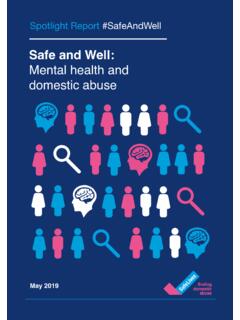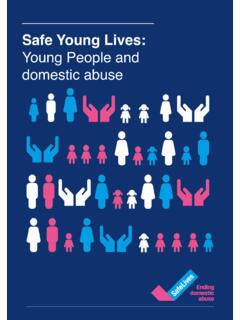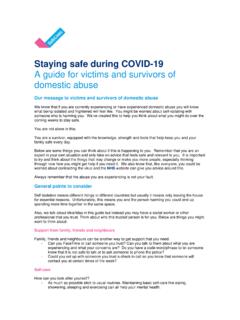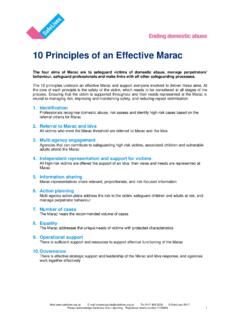Transcription of SafeLives Dash risk checklist Frequently asked questions
1 SafeLives dash risk checklist Frequently asked questions The introduction of the new checklist has raised a number of practical questions about its use. We have attempted to address some of these below. However, we anticipate that more will become evident as the tool is used more widely in the coming months. We therefore plan to update these FAQs as appropriate. Please visit to be sure that you have the latest version. What is the dash risk checklist for? The purpose of the checklist is to give a consistent and simple to use tool to practitioners who work with victims of domestic abuse in order to help them identify those who are at high risk of harm and whose cases should be referred to a MARAC meeting in order to manage the risk.
2 Who should use it? We believe that the primary audience will be front line practitioners working with victims of domestic abuse who are represented at MARAC. This will include both domestic abuse specialists such as IDVAs and generic practitioners such as those working in a primary care health service or housing. Over time an increasing range of agencies will feel confident to use the checklist with their clients or service users. The checklist has been designed with this goal in mind and the practice guidance aims to support those practitioners who are perhaps less confident in addressing the questions contained within it.
3 When should the dash risk checklist be used? The dash should be used whenever a practitioner receives an initial disclosure of domestic abuse. As you will be aware, risk in domestic abuse situations is dynamic and can change very quickly. Thus it may be appropriate to review the checklist with a client on more than one occasion. It is designed to be used for those suffering current rather than historic domestic abuse and ideally would be used close in time to the last incident of abuse that somebody has suffered. Why should one use it? Using an evidence based risk identification tool increases the likelihood of the victim being responded to appropriately and therefore of addressing the risks they face.
4 The dash risk checklist gives practitioners common criteria and a common language of risk. Do I have to ask every question ? Yes. It is important that we get a comprehensive view of the risks that somebody suffers. Without this, there is a danger that one may overlook something significant in a case which causes an agency's response to be inadequate. Is this now the same as the police version? The two models of the risk identification checklist and the risk assessment and management tool used by the police are now completely aligned and are based on the same analysis and approach. However, there are practical differences in the responsibility held by police officers and the risk tool for police is more extensive covering a full risk assessment and risk management information pack as well as three additional questions which clarify the situation in relation to children.
5 If you have further questions about the police model, please contact your local force champion or Staff Officer ACPO DA National 01380. 734035. Can you explain the referral thresholds included in the guidance? 0117 317 8750. SafeLives 2015. Please acknowledge SafeLives when reprinting. Registered charity number 1106864. 1. There is a detailed explanation of the referral thresholds in the new risk identification document but they are based on three principles. Firstly, we know that in many cases it will be necessary for professionals to use their judgement as to the risk that a victim faces although completion of the checklist is essential in having an informed professional judgement.
6 However, there will be situations where a victim either refuses to answer questions or answers only a very few but it is the professional's judgement that they are at high risk of harm. Conversely, there will be instances where a victim is prepared to answer the full range of questions and there we would recommend, based on our research, that a threshold of 14 ticks or above is a defensible position to take when referring a case to MARAC. Finally, there may be instances of escalation of violence where there are numerous smaller'. incidents and this too can be a catalyst to taking a case to MARAC, sharing information and getting a better picture of the true situation.
7 In practice, domestic abuse experts will tend to rely on professional judgement combined with the actuarial threshold, while less experienced or specialist practitioners will use the actuarial threshold on its own. What about cases that do not meet the threshold of 14 ticks? Inevitably, there will be cases that fall just below the actuarial threshold where you as a practitioner have genuine concerns about a victim and here you have full discretion to use your professional judgement to refer them into the meeting. In some areas IDVA services may have the capacity to take more referrals than simply the MARAC. caseload.
8 If this is the case, then we would suggest that taking referrals based on professional judgement of high risk or down to' 10 ticks on the new checklist would be an appropriate level based on the research that we have done to date. We would stress, however, that it is up to each individual service to take this decision and review it at regular intervals based on the caseload and referrals that they are receiving. What is the Severity of Abuse Grid? The severity of abuse grid is a tool that has been developed to help identify more precisely both the severity of risk that an individual faces and also how that risk changes over time.
9 It is particularly useful for IDVAs when they are opening a case with a client and also when closing a case in order to have some firm information on which to base this decision. There is full guidance on using the grid in the risk identification checklist pack. How does the checklist work in relation to honour'-based violence? You will see that all of the questions now include the possibility that there is more than one perpetrator in a case thus giving victims the option of disclosing additional people who they are frightened of, or who they feel threatened by, in addition to an intimate partner. Further, there are direct questions about honour'-based violence in the checklist which will help practitioners to identify these cases.
10 It is important to stress that it is highly likely that you will need to use your professional judgement in identifying whether an honour'-based violence case should be referred to MARAC since much of the checklist covers wider criminal behaviour which may be absent in cases of honour'-based violence and thus they are unlikely to meet the actuarial threshold for referral. The security issues around information sharing are particularly relevant in cases of honour'-based violence and the victim must ALWAYS be asked who it is safe to share information with. Please note that during the piloting of the checklist it served to help identify a very small number of HBV.










